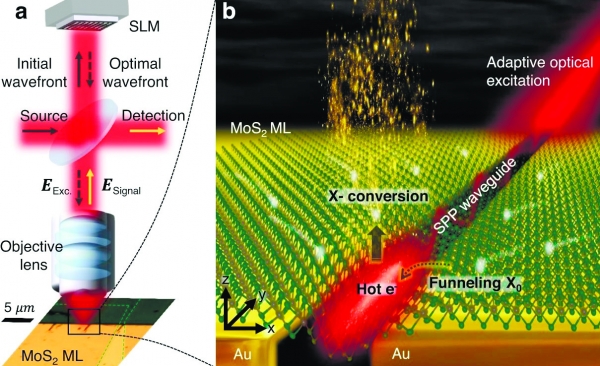
Bruce, from the movie Bruce Almighty, receives the power to control the world from God. The film ends as Bruce loses his superpower and returns to normalcy, but for a moment, he lives the sweetest dream of being almighty. Likewise, things do not go as one wishes, especially when dealing with light. Nevertheless, the POSTECH research team of Professor Kyoung-Duck Park (PHYS) and Hyeongwoo Lee successfully controlled trions, which can be an essential element in optical communication development. They utilized nanoplasmonic waveguides to produce high-purity trions and manipulate where the particle is created.
When light hits a semiconductive material, an exciton is created. An exciton is an electrically neutral particle composed of an electron and an electron hole. When an exciton bonds with an electron, it becomes a trion. Both excitons and trions are used in solar panels and optical communication devices; however, trions have an advantage in application because they are controllable using an electric field, and its bond breaks easily.
The researchers used a nanoplasmonic waveguide with a width of 200 nm to generate trions. A plasmonic waveguide is a pathway that controls the movement of plasmon by trapping it in a space smaller than its wavelength. When a 2D semiconductor is transferred onto the plasmonic waveguide, the semiconductor is stretched along the nanogaps of the plasmonic waveguide. Then, when light is emitted, excitons generated in the semiconductor gather at the center of the waveguide as if water flows through a funnel. Meanwhile, plasmons of waveguide have high energy, so they transfer the electrons in the metal of the waveguide to the semiconductor. As a result, excitons and electrons meet at the center of the waveguide and bond to produce trions.
Furthermore, the research team found a method that enables the spatio-spectral modulation of exciton-to-trion interconversion. With the technique, it is possible to generate plasmons at desired locations in the plasmonic waveguide and control the location of exciton-to-trion interconversion.
This research is a profound achievement because researchers used light instead of electricity. The team expects their results to contribute to the efficient control of trion-based optical devices and high-efficiency photoconversion devices. Hyeongwoo Lee, the
first author, said, “We are planning to research semiconductor-based long-distance communication based upon our findings about generating and controlling trions in nano space.”
The research was published in Nature Communications on April 12, and it was supported by the National Research Foundation of Korea (NRF), the Ministry of Science and ICT (MSIT), and the Samsung Science & Technology Foundation.


